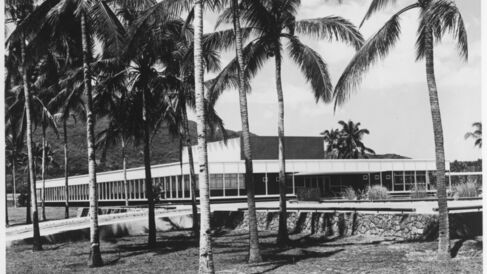Historical Perspectives on the Consultative Group on International Agricultural Research (CGIAR)

Co-leads: Helen Anne Curry and Timothy W. Lorek (College of St Scholastica, Minnesota)
This project explores the influences and legacies of the CGIAR, originally known as the Consultative Group on International Agricultural Research, 50 years after its founding.
Edited Collection
Helen Anne Curry and Timothy W. Lorek co-edited the volume Agricultural Science as International Development: Historical Perspectives on the CGIAR Era. The volume, published by the Cambridge University Press in November 2024, brings together leading historians and sociologists of agricultural research and international development to explore the influence of CGIAR and its affiliated research centres on agriculture, science, and policy since the 1970s. They ask whether and how science- and centre-led development changed the practices of farmers, researchers, and policymakers. Twelve original chapters traverse five continents and five decades of scientific research, agricultural aid, and political transformation.
Workshop
Many contributions to the edited volume Agricultural Science as International Development were first discussed at workshop series held 21–22 June and 28 June 2021.This workshop series was organised by Helen Anne Curry and Timothy Lorek.
Workshop description
For nearly fifty years, international aid for agricultural research has been shaped by an unusual partnership: an ad-hoc consortium of national governments, foreign aid agencies, philanthropies, UN agencies, and international financial institutions called the Consultative Group on International Agricultural Research (CGIAR). Formed in 1971 on the heels of the first celebrations of a Green Revolution in 1968, CGIAR was tasked with extending that apparent transformation in agricultural production to new countries and new crops. Its initial model prized two elements. International Agricultural Research Centers would hire international experts and develop and deliver research-based interventions. Meanwhile a Technical Advisory Committee, a select group of scientists, would prioritise areas of need to be addressed at the research centres with resources from CGIAR donors. The research centres quickly mushroomed from the founding four in 1971 to thirteen in 1983 and eighteen a decade later; today there are fifteen CGIAR research centres. During its first half century, the language of CGIAR centres’ research and development missions has evolved from Cold War security concerns to new terminology like food security, gender equity, and sustainability. Although the language, mechanisms of funding, and decision-making have changed in the intervening decades, CGIAR and this network of research centres remain powerful actors in shaping international development and, with it, global agriculture.
This influence is widely acknowledged. Histories of twentieth-century agriculture and international development make frequent reference to CGIAR research centers, especially the most prominent of these, and occasionally to CGIAR itself. Yet if one sets institutional accounts aside, there are surprisingly few historical treatments that take these as their primary concern. The exceptions are the two centres made famous by their role in disseminating the wheat and rice varieties that made headlines in 1968: the International Center for the Improvement of Maize and Wheat (CIMMYT) and the International Rice Research Institute (IRRI). Even in these cases, the years around 1970 tend to mark the end point, and not a starting point, as the founding of CGIAR at that time would suggest.
The year 2021 marks the fiftieth anniversary of the CGIAR, and motivates our bringing together a group of scholars with expertise in the history of CGIAR and the international agricultural research centers. In this anniversary year, this group will collaborate in the preparation of a volume that explores the influence of the CGIAR on agriculture, science, and policy since the 1970s. It will also serve as a foundation for future directions in CGIAR studies as it will link broad international histories of development and the Green Revolution with deeply contextualized studies of particular crops, mechanisms, or locations.
Full Workshop Programme, June 2021Monday, June 21
- Prakash Kumar, “ICRISAT, Agronomists, and Postcolonial Imaginings in India”
- Harro Maat, “Breeding Environments: The Africa Rice Center and the Asia Imaginary”
- Rebekah Thompson and James Smith, “Reconsidering Excellence: The History of Natural and Social Science Research at the International Livestock Research Institute”
- Margreet van der Burg, “Gender Integration in CGIAR Agricultural Research for Development”
Tuesday, June 22
- Derek Byerlee and Gregory Edmeades, “Fifty Years of Change in Maize Research at CIMMYT”
- Tim Lorek, “Conflicted Landscape: CIAT and Sugarcane in Colombia”
- Lucas Mueller, “Solving 'Later-Generation Development Problems' through ICRISAT: Plants, Farmers, and Markets in the 1970s”
- David Jefferson, “The Evolution of the Public Goods Model of Agricultural Research: Navigating Intellectual Property Within the CGIAR”
Monday, June 28
- Helen Anne Curry and Sabina Leonelli, “Describing Crops in the CGIAR Era”
- Marianna Fenzi, “Crop Diversity under CGIAR's Lens”
- Courtney Fullilove, “Poverty Alleviation and Biodiversity Preservation as Mandates in International Agricultural Research in the MENA (Middle East/North Africa) Region”
- Gabriela Soto Laveaga, “CIMMYT: Genetically Mexican, Designed to be Global”
